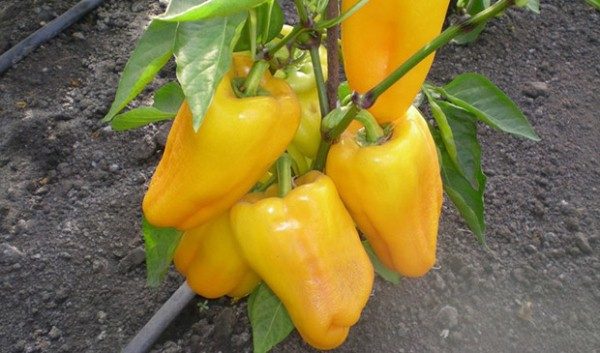
From the middle of the 18th century, peppers were grown on the territory of the Russian Empire. Now there are about 200 of its varieties. At the beginning of the new millennium, the Yellow Bell variety was bred. It differs from its brothers in its excellent characteristics. Thanks to this distinction, the variety is gaining ground more and more, prompting all who have tried these juicy and tasty fruits to leave only positive reviews. And looking at the photos of peppers, I want to try to plant them in my garden plot.
Russian gardeners grow a large number of peppers. One of its varieties is the Yellow Bell. It has excellent features. Based on them and the description of the variety, amateur gardeners decide to plant seeds on their site. No negative reviews of this variety can be found on the Internet. Its productivity is so high that subsequently many plant it again and again, and post photos in their accounts, causing admiration of other lovers of this culture.
Content
Description of the variety "Yellow Bell"
In recent years, the Yellow Bell has become increasingly popular. It is planted everywhere: in the southern and northern regions of the Russian Federation. If in the south it gives an excellent harvest without specially created conditions, then in the northern regions the variety must be grown in a greenhouse. Like many varieties of peppers, the "Yellow Bell" can not be grown in the Far North.
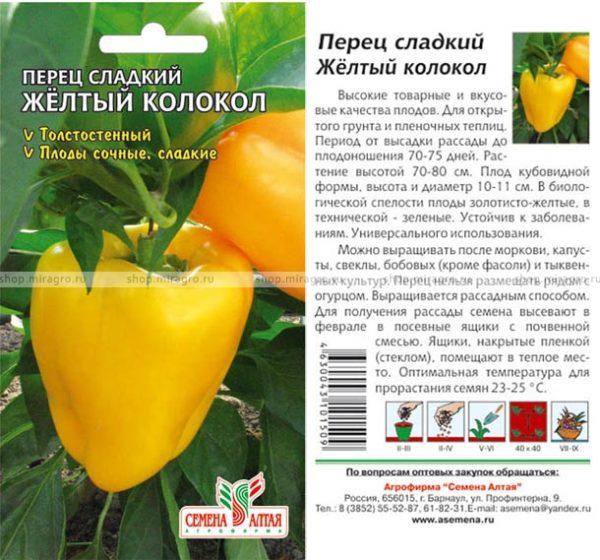
The plant has a number of advantageous characteristics:
- The ripening speed of the Yellow Bell fruit. From planting seedlings in the soil to the formation of fruits usually takes from 70 to 75 days.
- The variety is grown in open ground and film greenhouses.
- The bushes are medium-sized, but sometimes their height can reach one and a half meters.
- The fruits have a cuboid shape, mass from 120 to 170 g. But sometimes there are specimens with a mass exceeding 200 g. Peppers have a wall thickness of 7 to 10 mm. Before ripening, the fruits are colored green, it gradually changes during the period of biological ripeness to rich yellow.
- With one square meter of the site with proper care, you can collect a large number of fruits. About 8 kg are collected in greenhouse shelters; in open ground, the amount of yield varies from 2 to 6 kg.
- On each of the bushes at the same time from 7 to 10 fruits can be tied.
- The plant variety "Yellow Bell" is resistant to various diseases, including the one called tobacco mosaic.
- The plant can bear fruit in all weather conditions.
- Peppers are unpretentious and versatile.
- Fruit ripening occurs at the same time.
- Plants have large, broad leaves. In appearance, they look like a barrel or bell, which gave the name.
Rules for growing yellow bell peppers
Pepper seeds are usually planted in seedlings in mid-February. They are initially checked to see if they can ascend. Pure water from the tap is poured into a glass. A spoonful of salt is added to it and mixed well.

After receiving the solution, seeds are placed in it and left for some time.If the seeds remained floating on the surface and did not sink to the bottom, then they are collected with a spoon and discarded. Experienced gardeners assure that life-giving power is lost by such instances, so they will not sprout.
Simultaneously with the selection of seeds suitable for sowing, you must select the necessary containers in the form of suitable boxes or pots in size. Then you should pour soil into them.
After the container with the earth put inside the oven, where it is exposed to small temperature conditions. This is done for the purpose of steaming or heating.
Before planting, the seeds must be disinfected in a potassium permanganate solution for one and a half to two hours. After decontamination, the seeds should be soaked in Epins-extra or Kemira. These phytopreparations will help to further fight various diseases, strengthening the plant's immunity. In the absence of purchased drugs, you can use the juice of the agave. It has the same set of properties characteristic of specially developed herbal remedies.
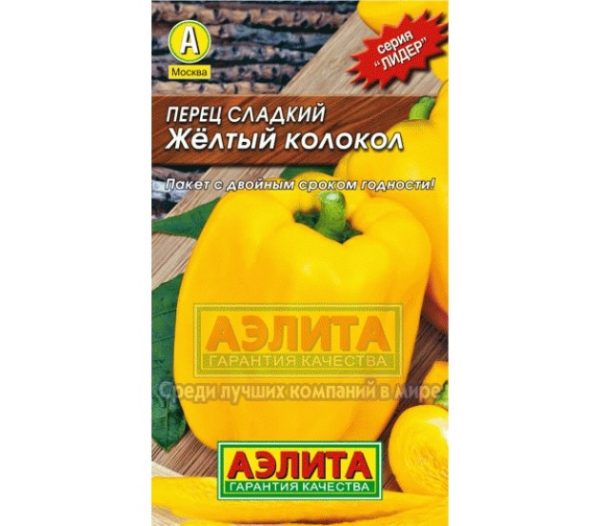
At the next stage, the treated seeds are wrapped in a damp cloth and placed in a warm place for several days. After 3-4 days, the seeds are checked for sprouts.
At the next stage, they are planted in pots or drawers. In order for young plants to appear faster, cover the containers with film material and put in a warm place. After the appearance of the tender first sprouts, the film is removed, and the plant is placed on the windowsill, well warmed by the sun.
After 3-5 leaves appeared on the stem, peppers are dived, planted in separate containers.
Transfer to a permanent place
After waiting for the plant to grow, it is necessary to transplant it to a specially prepared area for this. The Yellow Bell variety is well established on light and fertile lands. It is optimal to plant pepper after cabbage, onions, cucumbers, pumpkins. Peppers from the soil on which green manure plants previously grew provide excellent yields. They can replace fertilizers.
If the garden plot is small and it is difficult to make the choice of suitable land for planting peppers, you can dig the same plot by adding a large amount of fertilizer during work.
For planting, small grooves are made, into which, after 40 cm, seedlings are planted. Between the furrows, a 60-centimeter distance recedes. Soil is poured into small recesses, then a sprout is placed there, after having straightened the root system. It is important to leave the basal part on the surface. This measure will help to avoid decay of the plant. Then the remaining ground is completely filled up with the hole. Pepper is a very moisture-loving plant, so you should carefully water it.
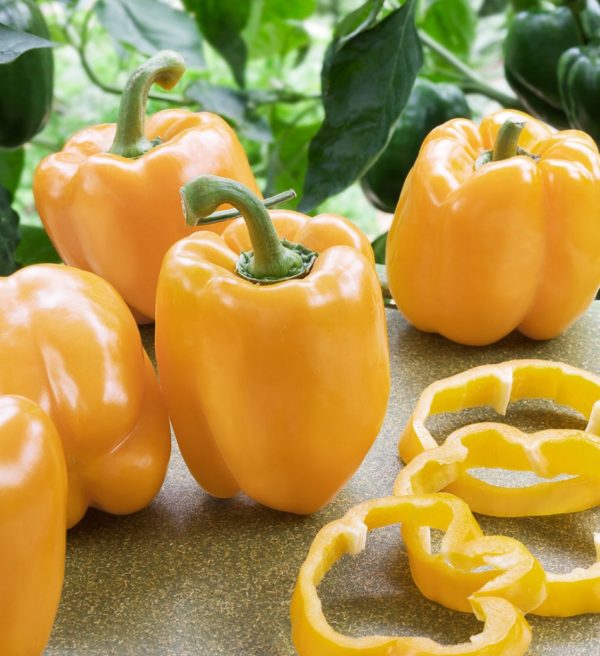
Experienced gardeners recommend fertilizing three times. For the first time, young seedlings are fed when 4-5 leaves appear on the stem. The second time fertilizer is applied 20 days after the first feeding. And the last time they feed during the fruit loading period, since it is necessary to maintain the plant in a difficult period of fruiting.
In dry weather conditions, plants should be watered every day. You should beware of getting water on delicate leaves.During the summer period, the earth around the pepper loosens and weeds from weeds. This will provide better growth and excellent harvest.
Peppercorns usually ripen by the end of July. But the ripening of fruits occurs until the moment when the air temperature drops below 10 degrees. As soon as the first frosts strike, the plant dies.
Good Harvest Measures
Maximum yield is provided if:
- The roots are healthy and strong, at the time of transplantation they do not damage. To reduce the risk of damage, at the time of preparation of the holes should be driven next to each peg, on which an adult plant will then rest.
- If the weather is unfavorable, then the pepper is covered with plastic wrap. This measure will help prevent the death of the Yellow Bell variety.
- Since up to 10 peppercorns can be on the bush at the same time, they tie it up without fail.
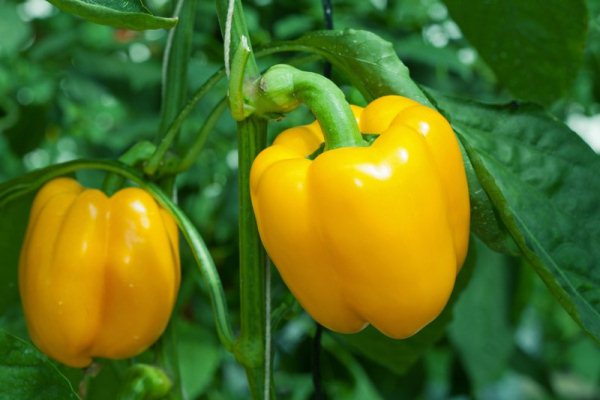
Disease control
Sometimes a plant can be susceptible to various diseases. To reduce the risk, you should:
- To prevent the "Black Leg" landing is carried out in good soil. In addition, water the plants with warm water, avoiding the passing winds and excessive moisture. If the soil on the site is susceptible to infection, then 5-7 cm of soil is removed, then the greenhouse is disinfected. To do this, you can use a sulfur block or bleach in a proportion of one to one. When planting young plants, it is necessary to reject weak and diseased specimens. In addition, the thickening of seedlings should not be allowed.
- To combat late blight disease, it is necessary to soak the seeds in potassium permanganate. The plant is re-processed already in July. Onion peel helps to cope with the disease.
- To prevent black bacterial spots, seed disinfection with a permanganate-potassium solution helps.
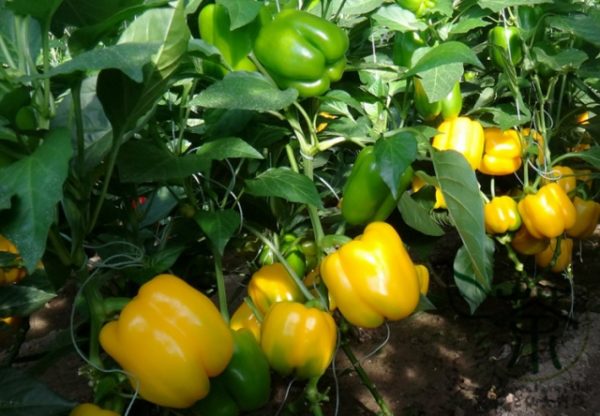
Reviews of gardeners
Many gardeners planting the Yellow Bell pepper leave positive feedback about it:
Semen, 47 years old, Astrakhan region
I have been growing peppers for over 20 years. This year, I accidentally bought seeds of the Yellow Bell variety and did not lose. Although the variety is late-ripening, the crop was already pleased in mid-July. The bushes are powerful, waving almost a meter and a half to a height. Plant diseases were not affected. I did not water it very often, as the summer was rainy. The only negative point is that from time to time weeds were harvested. Soon the fruits appeared. From 6 to 10 large peppercorns grew on each bush. I advise everyone.
Leonid Petrovich, 65 years old. Kostroma
3 years ago, a neighbor suggested taking seedlings from him for testing. Planted a few peppers and was pleasantly surprised by the harvest. Care of the crop is quite simple, moderate watering. Pepper grew large, each bush had a minimum of 5-6 fruits.




 Calorie pepper stuffed with meat and rice - BZHU per 100 grams
Calorie pepper stuffed with meat and rice - BZHU per 100 grams Gorky pepper - the best varieties for open ground
Gorky pepper - the best varieties for open ground Hot pepper seeds - the best varieties for open ground and reviews
Hot pepper seeds - the best varieties for open ground and reviews Capsicum tincture for hair - how to use and reviews
Capsicum tincture for hair - how to use and reviews